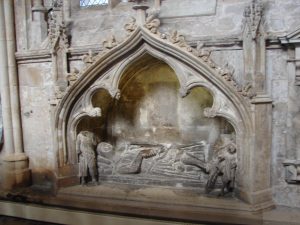 Memento Mori, the title of the third of my Lady Apollonia West Country Mysteries, was based on a Latin phrase which means to remember that you must die. Its use originated in classical times but was revived in medieval times. I chose it for my title because several deaths of people close to my heroine occur in the novel. The most significant loss occurred in the prologue describing the death of Apollonia’s second youngest son, Sir Alban. He succumbed to the bubonic plague while off on raids serving with the Teutonic Knights against Slavic peoples.
Memento Mori, the title of the third of my Lady Apollonia West Country Mysteries, was based on a Latin phrase which means to remember that you must die. Its use originated in classical times but was revived in medieval times. I chose it for my title because several deaths of people close to my heroine occur in the novel. The most significant loss occurred in the prologue describing the death of Apollonia’s second youngest son, Sir Alban. He succumbed to the bubonic plague while off on raids serving with the Teutonic Knights against Slavic peoples.
Although the story takes place over a year since the death of her beloved second husband, Edward Aust, and she has recently married Robert Windemere, Edward is still much on her mind as the story commences. Finally, the death of Apollonia’s long-time chaplain, Father Anthony, happens to her as another personal blow mid-way through the book.
The idea of “memento mori” is often put into poetic words such as:
Remember man, as you pass by,
As you are now, so once was I.
As I now am now, you soon shall be,
Prepare, therefore, to follow me.
On at least one occasion, the following codicil was added by a spouse:
To follow thee I’m not content,
Until I know just where thee went.
One of the ways in which Apollonia dealt with her grief for her son, Sir Alban, was to commission his tomb in the parish church in her home village of Aust. She wanted it to be an appropriate remembrance of him. My inspiration for that idea is the tomb in Exeter Cathedral which is pictured above. It shows such details as the knight’s horse and squire along with his effigy. The Lady Apollonia wished her son’s tomb to include the display his heart which had been brought home to her.
Transi or cadaver tombs began to appear in England at the end of the 14th century and became more common by the 15th century. These were tombs in which the effigy showed a decaying human body. Perhaps the huge number of deaths from bubonic plague of the 14th century encouraged this trend. I have used the image of a transi tomb in Exeter Cathedral for the cover of Memento Mori.
For more on Memento Mori, click on
https://en.wikipedia.org/wiki/Memento_mori
For more on transi tombs, click on
https://en.wikipedia.org/wiki/Cadaver_tomb